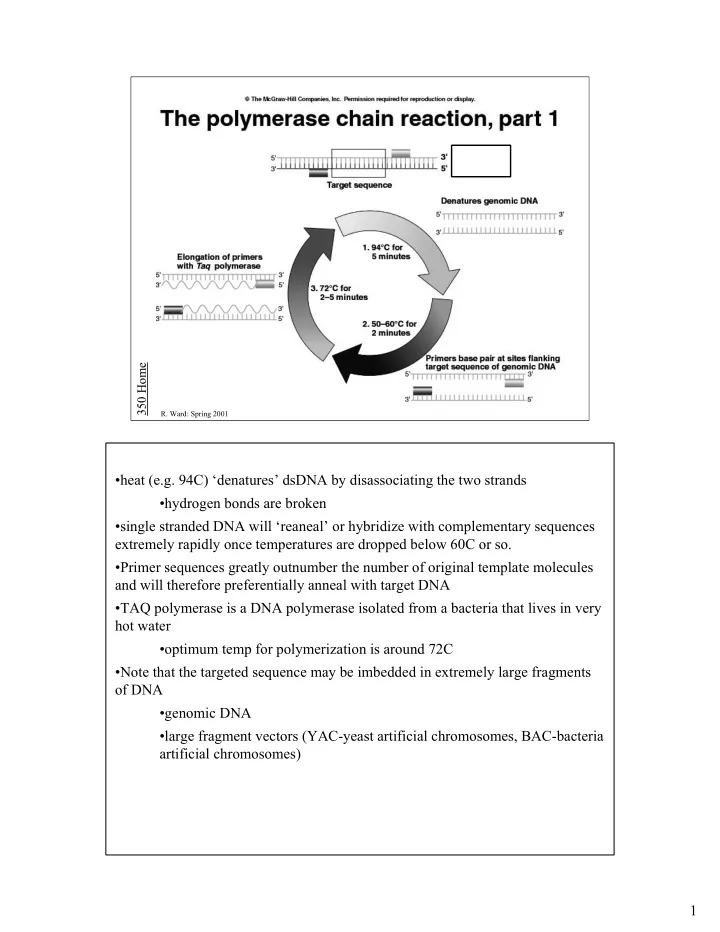

350 Home R. Ward: Spring 2001 •heat (e.g. 94C) ‘denatures’ dsDNA by disassociating the two strands •hydrogen bonds are broken •single stranded DNA will ‘reaneal’ or hybridize with complementary sequences extremely rapidly once temperatures are dropped below 60C or so. •Primer sequences greatly outnumber the number of original template molecules and will therefore preferentially anneal with target DNA •TAQ polymerase is a DNA polymerase isolated from a bacteria that lives in very hot water •optimum temp for polymerization is around 72C •Note that the targeted sequence may be imbedded in extremely large fragments of DNA •genomic DNA •large fragment vectors (YAC-yeast artificial chromosomes, BAC-bacteria artificial chromosomes) 1
350 Home R. Ward: Spring 2001 •after the first few cycles, most of the templates molecules are copies created during the previous cycles of PCR. •all products or amplicons begin and end with primer sequences or their complement 2
PCR: Polymerase Chain Reaction: in vitro Selective exponential amplification (replication) of a defined sequence of DNA � Requirements: � DNA template that has the targeted sequence • genomic DNA (all there is from a plant) • small or large fragment clones � you know the bp sequence (15 or more bp) of the sequences flanking the subsequence you want to amplify � oligonucleotide “primer” sequences complementary to the template terminal sequences � Thermal-stable DNA polymerase (Taq) • active at 70C, and not denatured at 95C � all four deoxy-nucleotides (dNTP) � “thermal cycler” unit to cyclically vary temperature with a defined 350 Home sequence and timing R. Ward: Spring 2001 See pages 294 and 295 in your text book. Notes: 3
MSU PCR reaction steps for Wheat Microsatellite amplification 1. 95C 3 min. Denature 95C 25s anneal 55C (variable) 25s 2. Extension (polymerize) 72C 45s 350 Home 38 cycles 3. 72C 10 min R. Ward: Spring 2001 4
Start P: 5’- ATGCATGCAT TTAACCGGAA -3’ I. P: 3’- TACCTACGTA AATTGGCCTT -5’ ds Template DNA Denature ( 94C) 5’- ATGCATGCAT TTAACCGGAA -3’ II. 3’- TACCTACGTA AATTGGCCTT -5’ ss Template DNA Reanneal and Polymerize 55C 25s, then 72C 25s P: 5’- ATGCATGCAT TTAACCGGAA -3’ G1: 3’ -TACGTACGTA AT TTGGCCTT- 5’ � REVERSE PRIMER III. 350 Home FORWARD PRIMER � G1: 5’-ATGGATGC AT TTAACCGGAA -3’ P: 3’- TACCTACGTA AATTGGCCTT -5’ R. Ward: Spring 2001 5
P: 5’- ATGCATGCAT TTAACCGGAA -3’ G2: 3’ -TACGTACGTA AT TTGGCCTT- 5’ � REVERSE PRIMER FORWARD PRIMER � G2: 5’-ATGGATGC AT TTAACCGGAA -3’ G1: 3’ -TACGTACGTA AT TTGGCCTT- 5’ AT G1: 5’-ATGGATGC TTAACCGGAA -3’ G2: 3’ -TACGTACGTA AT TTGGCCTT- 5’ � REVERSE PRIMER FORWARD PRIMER � G2: 5’-ATGGATGC AT TTAACCGGAA -3’ P: 3’- TACCTACGTA AATTGGCCTT -5’ 350 Home R. Ward: Spring 2001 6
PCR products � All “amplicons” or amplified fragments are identical in length � and start and end with the primer sequences � # molecules of product vastly outnumbers the number of initial template molecules � primers or nucleotides can be labeled for subsequent auto-detection 350 Home R. Ward: Spring 2001 7
PCR Products (II) � different sources of template can be amplified if they are complementary to the 3’ ends of both primers- even if they differ in the intervening sequences � exclusion of one primer results in a linear increase in copies of one strand of a template duplex 350 Home R. Ward: Spring 2001 8
PCR: Ingredients All in a single tube Template DNA Nucleotides (in great excess) Taq polymerase forward and reverse primers (in great excess) plus buffer solution 350 Home “eppendorf tube” R. Ward: Spring 2001 9
Multi-channel pipetter 350 Home R. Ward: Spring 2001 10
Tip attachment with Multi-chnnel pipetter 350 Home R. Ward: Spring 2001 11
96 well PCR plate 350 Home R. Ward: Spring 2001 12
MJ Quad PCR unit: 4 x 96 reactions 350 Home R. Ward: Spring 2001 13
Recommend
More recommend